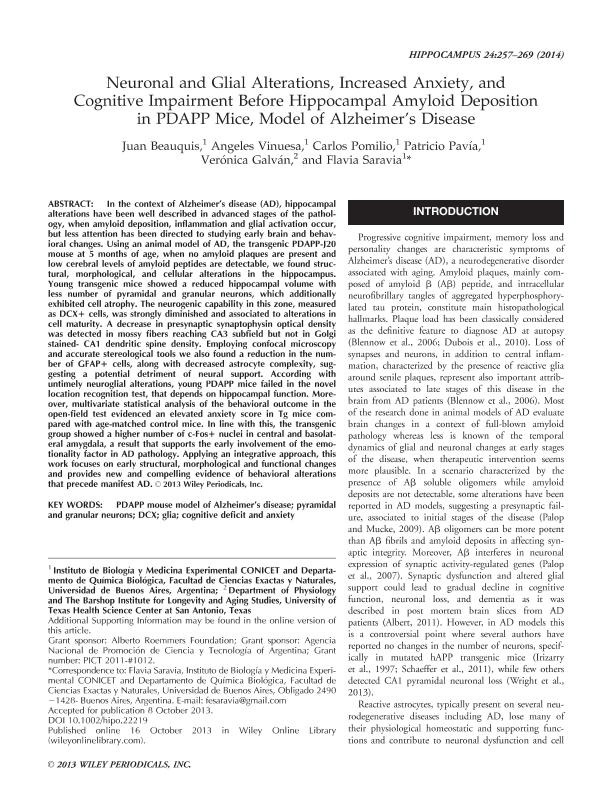Artículo
Neuronal and glial alterations, increased anxiety, and cognitive impairment before hippocampal amyloid deposition in PDAPP mice, model of Alzheimer's disease
Beauquis, Juan ; Vinuesa, María Angeles
; Vinuesa, María Angeles ; Pomilio, Carlos Javier
; Pomilio, Carlos Javier ; Pavía, Patricio Roberto; Galvan, Verónica; Saravia, Flavia Eugenia
; Pavía, Patricio Roberto; Galvan, Verónica; Saravia, Flavia Eugenia
 ; Vinuesa, María Angeles
; Vinuesa, María Angeles ; Pomilio, Carlos Javier
; Pomilio, Carlos Javier ; Pavía, Patricio Roberto; Galvan, Verónica; Saravia, Flavia Eugenia
; Pavía, Patricio Roberto; Galvan, Verónica; Saravia, Flavia Eugenia
Fecha de publicación:
14/02/2014
Editorial:
Wiley-liss, Div John Wiley & Sons Inc
Revista:
Hippocampus
ISSN:
1050-9631
e-ISSN:
1098-1063
Idioma:
Inglés
Tipo de recurso:
Artículo publicado
Clasificación temática:
Resumen
In the context of Alzheimer's disease (AD), hippocampal alterations have been well described in advanced stages of the pathology, when amyloid deposition, inflammation and glial activation occur, but less attention has been directed to studying early brain and behavioral changes. Using an animal model of AD, the transgenic PDAPP-J20 mouse at 5 months of age, when no amyloid plaques are present and low cerebral levels of amyloid peptides are detectable, we found structural, morphological, and cellular alterations in the hippocampus. Young transgenic mice showed a reduced hippocampal volume with less number of pyramidal and granular neurons, which additionally exhibited cell atrophy. The neurogenic capability in this zone, measured as DCX+ cells, was strongly diminished and associated to alterations in cell maturity. A decrease in presynaptic synaptophysin optical density was detected in mossy fibers reaching CA3 subfield but not in Golgi stained- CA1 dendritic spine density. Employing confocal microscopy and accurate stereological tools we also found a reduction in the number of GFAP+ cells, along with decreased astrocyte complexity, suggesting a potential detriment of neural support. According with untimely neuroglial alterations, young PDAPP mice failed in the novel location recognition test, that depends on hippocampal function. Moreover, multivariate statistical analysis of the behavioral outcome in the open-field test evidenced an elevated anxiety score in Tg mice compared with age-matched control mice. In line with this, the transgenic group showed a higher number of c-Fos+ nuclei in central and basolateral amygdala, a result that supports the early involvement of the emotionality factor in AD pathology. Applying an integrative approach, this work focuses on early structural, morphological and functional changes and provides new and compelling evidence of behavioral alterations that precede manifest AD.
Archivos asociados
Licencia
Identificadores
Colecciones
Articulos(IBYME)
Articulos de INST.DE BIOLOGIA Y MEDICINA EXPERIMENTAL (I)
Articulos de INST.DE BIOLOGIA Y MEDICINA EXPERIMENTAL (I)
Citación
Beauquis, Juan; Vinuesa, María Angeles; Pomilio, Carlos Javier; Pavía, Patricio Roberto; Galvan, Verónica; et al.; Neuronal and glial alterations, increased anxiety, and cognitive impairment before hippocampal amyloid deposition in PDAPP mice, model of Alzheimer's disease; Wiley-liss, Div John Wiley & Sons Inc; Hippocampus; 24; 3; 14-2-2014; 257-269
Compartir
Altmétricas



